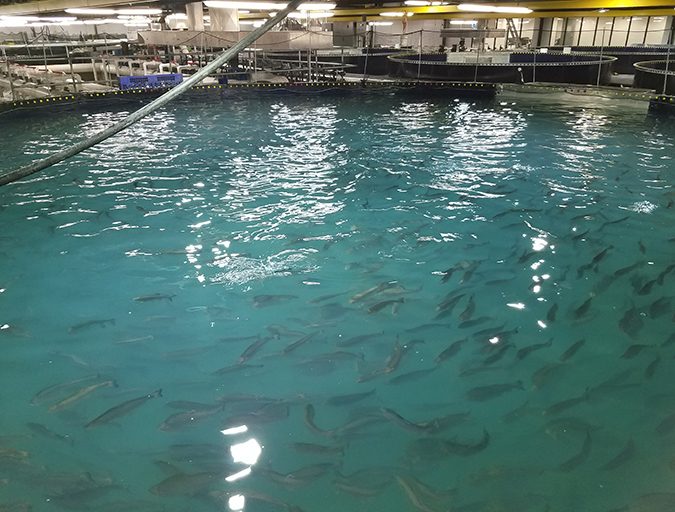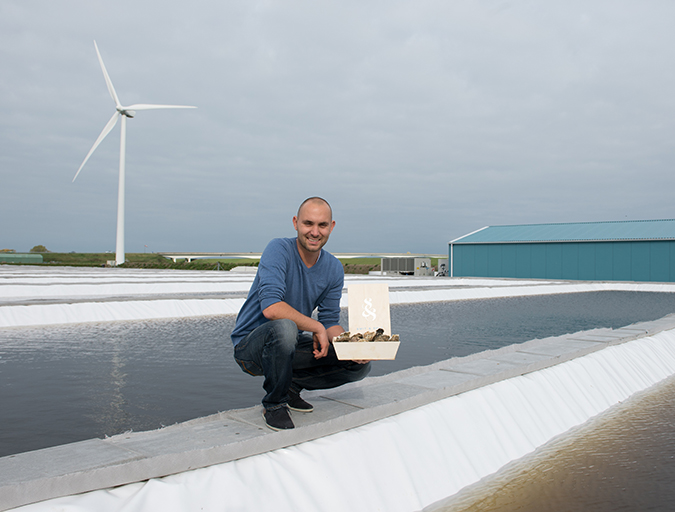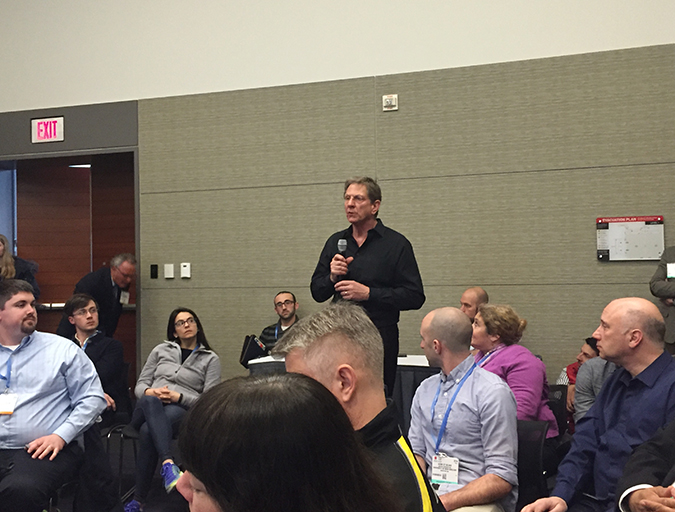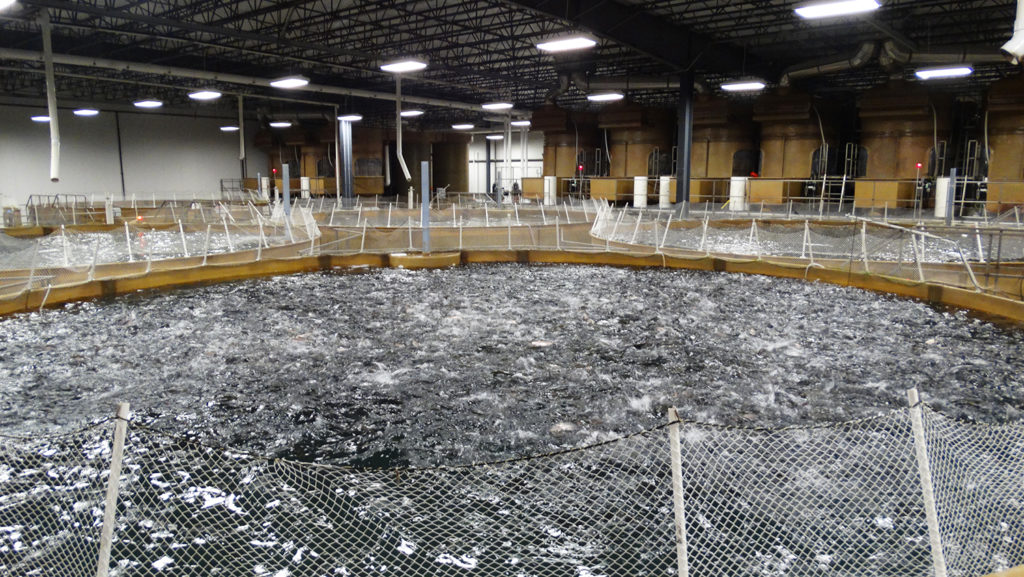At Hudson Valley Fish Farms, in tanks where tilapia once swam, a new owner and new species have taken over

At Hudson Valley Fish Farms, the nearest body of water, the Hudson River, lies three miles to the west. This is an indoor, recirculating aquaculture system designed to break fish farming’s dependency on the open ocean, where the vast majority of the world’s farmed salmon are grown, and where environmental impacts from fish farms have long concerned conservationists.
Instead of the Atlantic Ocean, which is some 165 miles to the east, this temperature-controlled warehouse, with its series of 10-foot-deep tanks with artificial currents and steady water temperatures of 59 degrees-F, is the salmon’s home.
“When people hear we’re farmed they think ‘yeah, it’s the same thing,’ but it’s really not. We can control things, like the firmness of the texture,” said Samuel Chen, Hudson Valley Fish Farms’ head of corporate and business development. “All these parameters that I’m able to control people don’t have the ability to control that in an open ocean.”
Much of Hudson Valley’s program is standard protocol: Fish eggs arrive from Washington-based Trout Lodge, and are kept in trays in the nursery until they hatch. Once the fish reach 30 grams – or smolt size – they are transferred to a tank where they learn to swim. Then, instead of relocating the fish to ocean pens, they are instead moved through a series of tanks until they reach market size of 3 kg.
Hudson Valley’s farm has 1,200-metric-ton annual capacity and is set on the site of a former cement pipe producing plant. The largest tanks are 45 feet in diameter with a total 9,000 cubic meters of tank water volume. There’s an oxygen injection system, and a system for capturing carbon dioxide and oxygen.
There are mechanical filtration systems and biofiltration systems everywhere – to clean the water when it comes in and to remove the fish waste when it goes out. The farm’s plan is to collect all waste – from carbon dioxide to feces – for use in its two 80,000 square-foot greenhouses.
“At some point we’re going to be able to use our nutrients, and the nutrient rich water, plus the CO2 we collect. People talk about the value of these different things, and CO2 is one people don’t usually think about,” said Chen.
“Why do we farm indoors? Because we love seals,” Chen quipped. His point being that tank farming eliminates the environmental impacts of open ocean net pens. With an entirely land-based system there are no predators to ward off, no pollutants or excess feed accumulating on the ocean floor, and an extremely low risk of disease for the fish.
“Nutrients in low quantities are good; nutrients in high quantities become toxic and end up killing things,” said Chen. “What happens with a lot of net pen environments is all that poop falls to the ocean floor. And when you’re concentrating in a net pen environment, that’s not something great for us. We have the ability to collect that. I can collect it, and mineralize it, and make a fertilizer from it. That fertilizer is very useful for land applications; for growing plants.”
For now, the steelhead salmon (Oncorhynchus mykiss) here are fed by hand, as a training mechanism for the staff. Chen wants the team to learn the fish patterns and habits so that when they move to automated feeding the staff will still have a feel for what the fish want and need, even if they are operating the delivery remotely. Meanwhile, the team also controls for flesh firmness by exercising the fish using a carefully calibrated water force inside the tanks.
The salmon fillets are a candy-bright red. As with most farms, the feed for these fish contains astaxanthin to provide the necessary pigment. What’s unique about the feed is the blend: Believing that soy-based feed changes the taste of the fish, they created a proprietary blend that includes trimmings from Alaskan processors, and a bacteria-based astaxanthin.
Whereas wild salmon get their distinctive pigment from various crustaceans, astaxanthin is primarily sourced from microalgae, yeast and bacteria. Hudson Valley found the algae form largely consumed by human use – think supplements – so they turned to an organic, bacteria-based product that they like for its uptake and availability.
This is not the first fish farm to operate on this 120-acre parcel of land. Local Ocean Seafood ran a tilapia farm here from 2009 to 2013, when it was foreclosed upon by lenders. Their failure became Chen’s advantage. While supping on sushi in Manhattan, a fellow diner tried to warn Chen off tank farming with the story of Local Ocean’s failure. It was exactly the opportunity Chen was looking for: a site that had already been purposed for a fish farm, and one that could be outfitted to Hudson Valley’s specifications.
What sets the two businesses apart is both the funding model and the species being raised. Where Local Ocean had investors, Hudson Valley Fish Farms has family. Chen’s uncle, who has spent the last 25 years in the plastics and metals recycling industry, has provided all the funding for the venture – some $40 million to date, says Chen. He’ll continue to fund the farm until the model is proven.
While Hudson is largely dedicated to raising salmon, it also has a shrimp pilot program on site, with 16 shrimp raceways. Until they get to year-round availability the program will remain in pilot stage, although Hudson Valley’s last harvest was a full ton of shrimp. Given the abbreviated production timeline – a four-month grow-out, versus 24 for salmon – and Americans’ affinity for the crustaceans, it’s a good fit. Meanwhile, restaurants in the region are eagerly anticipating the salmon’s arrival in the marketplace, and Chen has been establishing relationships with larger buyers. They anticipate producing 44,000 pounds of salmon per week.
Assuming they can prove the model, Hudson Valley Fish Farms won’t be the company’s last farm. They see the Hudson locale as a pilot to prove that land-based fish farming, located in close proximity to major metropolitan markets, can be successful.
For now, the only fish hitting dinner plates are the ones that Chen and team harvest each Friday, for necropsy and taste testing. Once the fish have reached full size and the farm has installed a harvesting system – they don’t plan to go the stun and bleed route – the salmon will hit the market, potentially as early as this spring.
“There’s a belief that wild is the premium product. Some of the best salmon I’ve ever had is wild, and some of the worst I’ve ever had is also wild,” said Chen. “Husbandry is what impacts the quality of the animal, of what you’re eating at the end of the day. Husbandry is king.”
Author
-
Julie H. Case
Julie H. Case writes about travel, wine, food, science, mushrooms and more. Her work has appeared everywhere from Alaska Airlines Magazine to Wired
Tagged With
Related Posts

Intelligence
Dutch shellfish farmers bringing the sea onto land
Bivalve shellfish culture is a low-impact form of protein production, and in many cases is a net-positive for water quality. So why move it indoors? Smit & Smit in the Netherlands has a good argument for doing so.

Intelligence
Boston brainstorm: Getting consumers to embrace aquaculture
In a discussion format somewhat unique to the bustling halls of Seafood Expo North America, aquaculture backers lamented the lackluster U.S. consumer acceptance for farmed fish.

Innovation & Investment
AquaBounty, with new RAS facility, hopes to win public support for GM salmon
Ron Stotish, CEO of AquaBounty Technologies, believes genetically modified salmon is no threat to its opponents and the outlook for AquAdvantage is good. With its purchase of the Bell Fish Co. RAS facility, commercialization will soon commence.

Intelligence
AquaBounty, con nueva instalación RAS, espera ganar apoyo público para el salmón GM
Ron Stotish, CEO de AquaBounty Technologies, cree que el salmón genéticamente modificado no es una amenaza para sus oponentes y que la perspectiva de AquAdvantage es buena. Con la compra de la instalación RAS de Bell Fish Co., la comercialización comenzará pronto.


